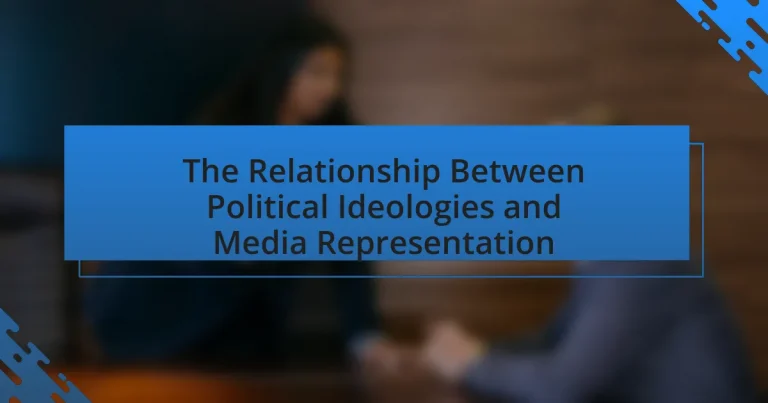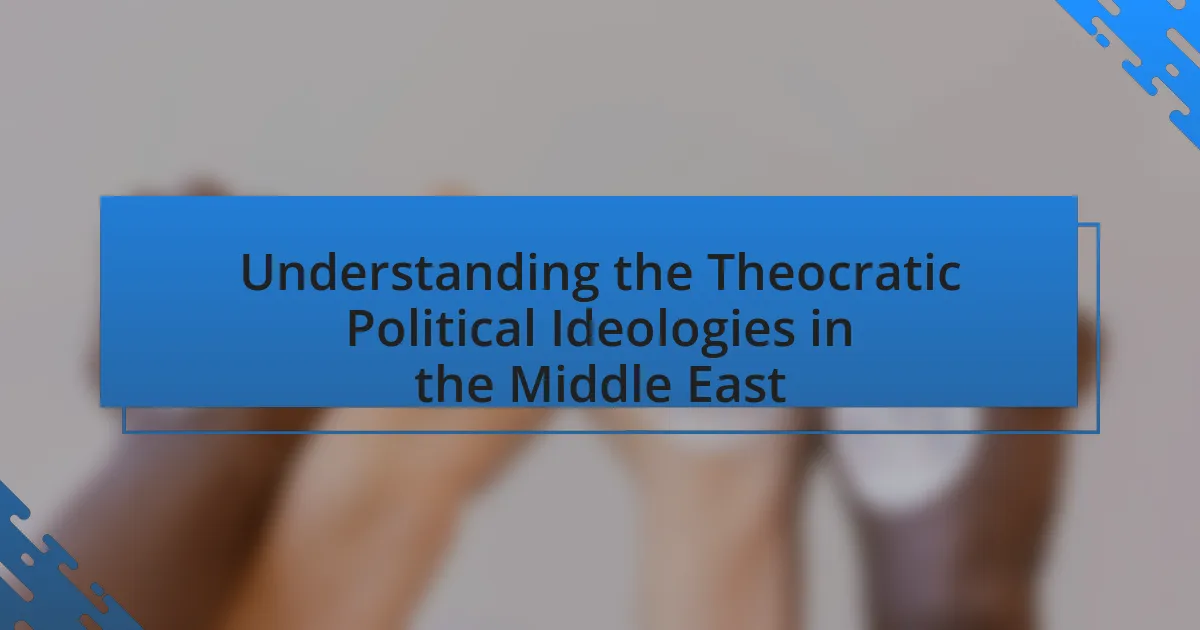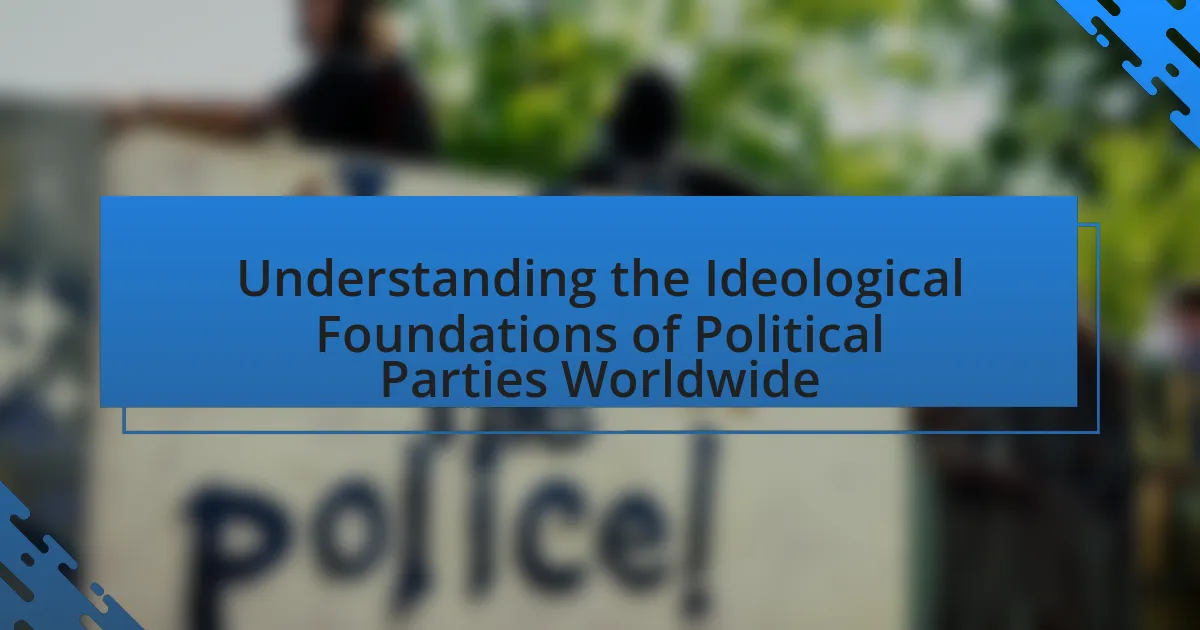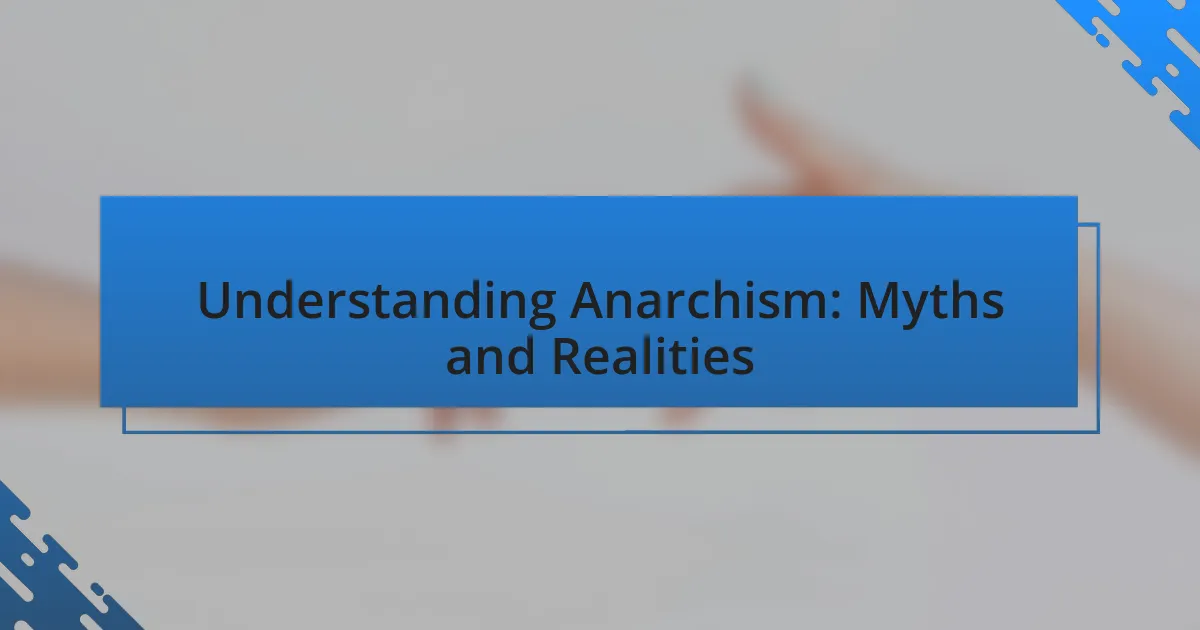The article examines the relationship between political ideologies and media representation, highlighting how ideologies shape narratives, framing, and content produced by media outlets. It discusses the influence of key political ideologies such as liberalism, conservatism, socialism, and feminism on media narratives and the alignment of media organizations with specific ideological perspectives. The article also explores the implications of biased media representation on public perception, political polarization, and the importance of diverse media representation in a democratic society. Additionally, it addresses the role of audience demographics in media consumption and offers strategies for promoting balanced media representation and enhancing media literacy.
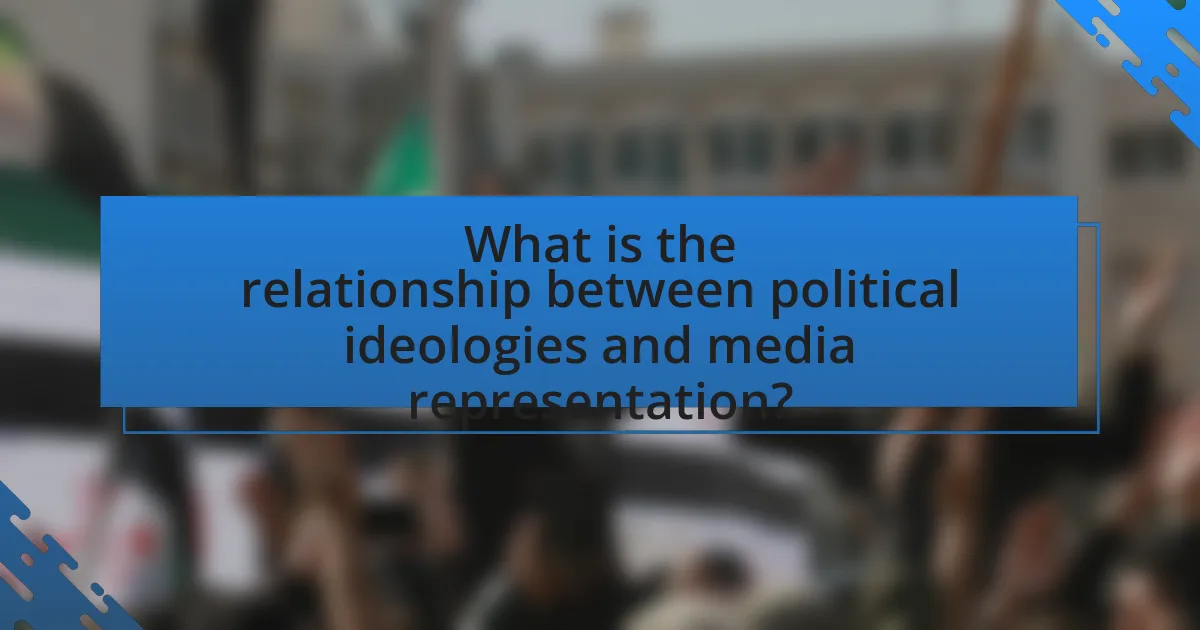
What is the relationship between political ideologies and media representation?
Political ideologies significantly influence media representation by shaping the narratives, framing, and content that media outlets produce. For instance, media organizations often align their reporting and editorial choices with specific ideological perspectives, which can lead to biased portrayals of events, groups, or policies. Research indicates that conservative and liberal media outlets present news stories in ways that reflect their ideological leanings, affecting public perception and discourse. A study by the Pew Research Center found that individuals who consume news from ideologically aligned sources are more likely to hold polarized views, demonstrating the direct impact of media representation on political ideology.
How do political ideologies influence media narratives?
Political ideologies significantly influence media narratives by shaping the framing, selection, and interpretation of news stories. For instance, media outlets aligned with conservative ideologies may emphasize themes of individualism and personal responsibility, while liberal outlets might focus on social justice and collective action. Research indicates that media bias can affect public perception; a study by the Pew Research Center found that individuals who consume news from ideologically aligned sources are more likely to adopt similar viewpoints, reinforcing existing beliefs. This dynamic illustrates how political ideologies not only dictate the content presented but also influence audience interpretation and engagement with media narratives.
What are the key political ideologies that shape media representation?
Key political ideologies that shape media representation include liberalism, conservatism, socialism, and feminism. Liberalism promotes individual rights and freedoms, often leading to media that emphasizes diversity and social justice. Conservatism typically focuses on tradition and stability, resulting in media that may prioritize national identity and moral values. Socialism advocates for social ownership and equality, influencing media to highlight class struggles and collective rights. Feminism seeks to address gender inequalities, shaping media narratives to challenge patriarchal structures and promote women’s voices. These ideologies directly impact how stories are framed, whose voices are amplified, and the overall portrayal of societal issues in the media landscape.
How do media outlets align with specific political ideologies?
Media outlets align with specific political ideologies by curating content that reflects particular values, beliefs, and perspectives associated with those ideologies. For instance, conservative media outlets like Fox News often emphasize traditional values, free-market principles, and a strong national defense, while liberal outlets such as MSNBC focus on social justice, environmental issues, and government intervention in the economy. This alignment is evident in their choice of stories, framing of issues, and selection of expert commentators, which collectively shape public perception and discourse. Research indicates that media consumption patterns often correlate with political beliefs, as individuals tend to gravitate towards outlets that reinforce their ideological views, thereby creating echo chambers that further entrench these alignments.
Why is media representation important in a democratic society?
Media representation is crucial in a democratic society because it shapes public perception and influences political discourse. Accurate and diverse media representation ensures that various voices and perspectives are heard, fostering informed citizenry and promoting accountability among leaders. Studies show that when marginalized groups are represented in media, it can lead to increased political engagement and advocacy for their rights, as evidenced by the rise in voter turnout among underrepresented demographics following positive media portrayals. Thus, media representation directly impacts the health of democracy by facilitating participation and ensuring that all segments of society are considered in the political process.
How does media representation affect public perception of political issues?
Media representation significantly shapes public perception of political issues by influencing how information is framed and prioritized. When media outlets emphasize certain narratives or perspectives, they can create biases that affect audience understanding and opinions. For instance, studies have shown that coverage of immigration issues often highlights negative aspects, leading to increased public fear and opposition to immigration policies. Research by the Pew Research Center indicates that individuals exposed to predominantly negative media portrayals of immigrants are more likely to hold unfavorable views towards them. This demonstrates that the way political issues are represented in media directly correlates with public attitudes and beliefs, ultimately impacting political discourse and policy-making.
What role does media play in shaping political discourse?
Media plays a crucial role in shaping political discourse by influencing public perception and framing political issues. Through selective coverage, media outlets can highlight specific narratives, thereby guiding the public’s understanding and opinions on political matters. For instance, studies have shown that the framing of news stories can significantly affect how audiences interpret political events, as evidenced by the 2016 U.S. presidential election, where media portrayal of candidates influenced voter perceptions and decisions. Furthermore, the rise of social media has amplified this effect, allowing for rapid dissemination of information and the ability for individuals to engage in political discussions, thus further shaping the discourse.
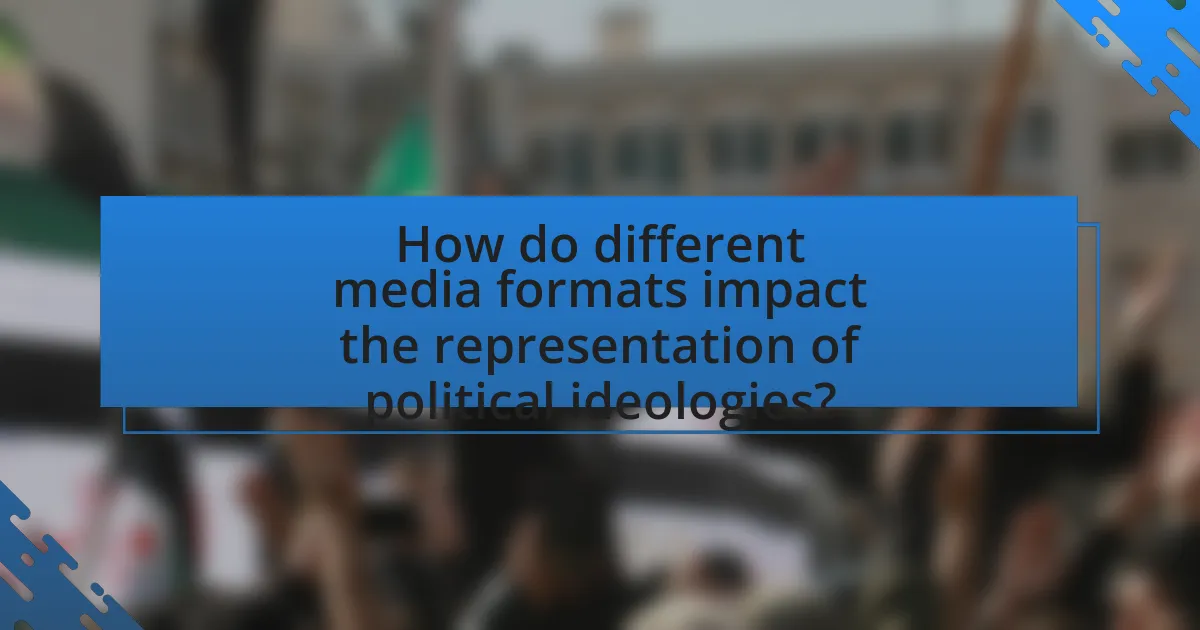
How do different media formats impact the representation of political ideologies?
Different media formats significantly impact the representation of political ideologies by shaping how information is presented and perceived. For instance, television news often emphasizes visual storytelling and emotional appeal, which can lead to a more sensationalized portrayal of political events, thereby influencing public perception and engagement with specific ideologies. In contrast, print media, such as newspapers, typically allows for more in-depth analysis and nuanced discussions, which can foster a more informed understanding of political ideologies. Research indicates that social media platforms, like Twitter and Facebook, facilitate rapid dissemination of information and can amplify partisan viewpoints, often leading to echo chambers that reinforce existing beliefs. A study by the Pew Research Center found that 62% of Americans get news from social media, highlighting its role in shaping political discourse and ideology representation. Thus, the format of media not only affects the style of communication but also the depth and breadth of ideological representation.
What are the differences in representation across various media platforms?
Representation across various media platforms differs significantly in terms of content, audience engagement, and ideological framing. Traditional media, such as newspapers and television, often adhere to established journalistic standards, providing a more uniform representation of political ideologies, whereas digital platforms, like social media, allow for diverse, user-generated content that can amplify niche perspectives. For instance, research by the Pew Research Center indicates that social media users are more likely to encounter politically homogeneous content, which can reinforce existing beliefs, while traditional media aims for a broader audience with balanced reporting. This divergence in representation shapes public perception and discourse, highlighting the influence of platform characteristics on political ideology dissemination.
How do traditional media and social media differ in political representation?
Traditional media and social media differ significantly in political representation by their modes of information dissemination and audience engagement. Traditional media, such as newspapers and television, typically operate under established editorial standards and gatekeeping processes, which can lead to a more uniform representation of political viewpoints, often favoring mainstream narratives. In contrast, social media platforms allow for a decentralized flow of information, enabling diverse voices and grassroots movements to emerge, which can challenge traditional narratives and promote alternative political perspectives. For example, during the Arab Spring, social media played a crucial role in mobilizing protests and disseminating information that traditional media outlets were slow to cover. This illustrates how social media can democratize political representation, while traditional media may reinforce existing power structures.
What impact does visual media have on the portrayal of political ideologies?
Visual media significantly influences the portrayal of political ideologies by shaping public perception and framing narratives. Research indicates that visual content, such as images and videos, can evoke emotional responses that reinforce specific ideological viewpoints. For instance, a study by the Pew Research Center found that visual media can amplify partisan divides, as individuals are more likely to share and engage with content that aligns with their political beliefs. This selective exposure to visual media not only affects individual opinions but also contributes to the broader societal discourse surrounding political ideologies, often leading to polarization.
How does audience demographic influence media representation of political ideologies?
Audience demographics significantly influence media representation of political ideologies by shaping the content and framing of narratives to align with the preferences and values of specific groups. Media outlets often tailor their messaging to resonate with their target audience’s age, race, gender, and socioeconomic status, which can lead to biased portrayals of political ideologies. For instance, research by the Pew Research Center indicates that younger audiences tend to favor progressive ideologies, prompting media platforms to highlight stories that reflect liberal viewpoints, while older demographics may prefer conservative narratives, resulting in a different emphasis in coverage. This selective representation can reinforce existing beliefs and create echo chambers, ultimately affecting public perception and discourse surrounding political ideologies.
What role do age, gender, and socioeconomic status play in media consumption?
Age, gender, and socioeconomic status significantly influence media consumption patterns. Younger audiences tend to favor digital platforms and social media, while older demographics often prefer traditional media such as television and newspapers. Gender differences manifest in content preferences, with women generally consuming more social and lifestyle content, whereas men may gravitate towards sports and news. Socioeconomic status affects access to technology and media; individuals from higher socioeconomic backgrounds typically have greater access to diverse media sources and platforms, leading to varied consumption habits. Research by the Pew Research Center indicates that 93% of adults aged 18-29 use social media, compared to 32% of those aged 65 and older, highlighting the stark differences in media consumption across age groups.
How do audience biases affect the interpretation of media messages?
Audience biases significantly influence the interpretation of media messages by shaping how individuals perceive and process information. These biases stem from pre-existing beliefs, values, and experiences, which filter the way media content is understood. For instance, research by the Pew Research Center indicates that individuals with strong political ideologies are more likely to interpret news stories in a manner that aligns with their beliefs, often leading to confirmation bias. This means that when audiences encounter media messages, they tend to favor information that supports their viewpoints while dismissing contradictory evidence. Such biases can distort the intended message of the media, resulting in polarized interpretations and reinforcing existing ideological divides.
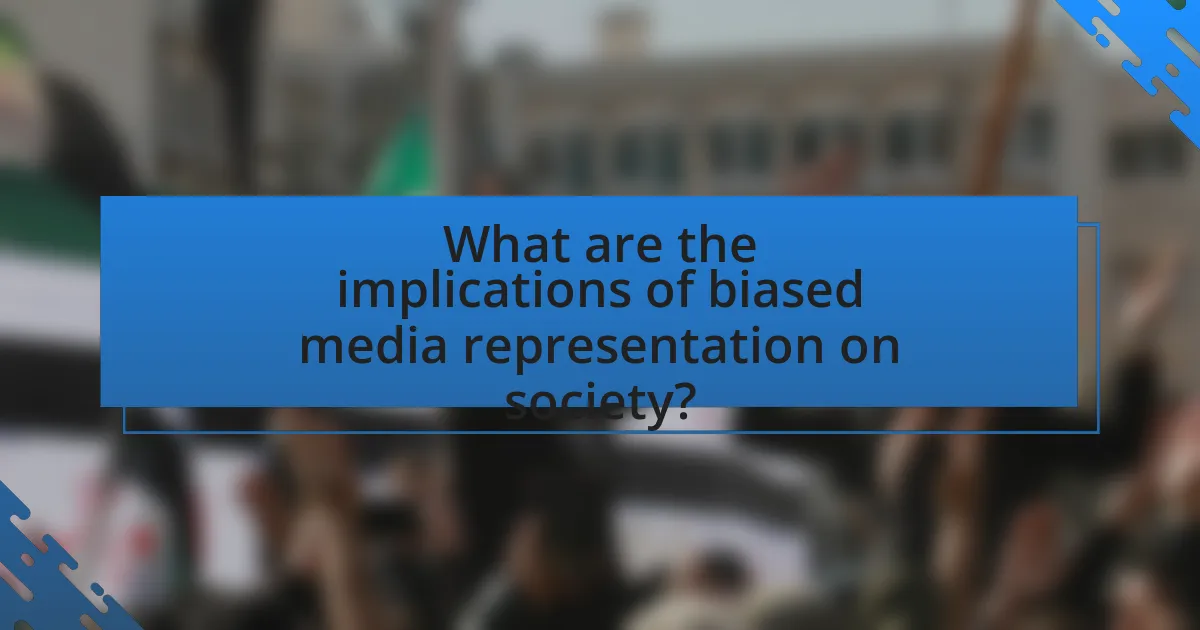
What are the implications of biased media representation on society?
Biased media representation significantly distorts public perception and understanding of social issues. This distortion can lead to the reinforcement of stereotypes, shaping societal attitudes and behaviors based on incomplete or skewed information. For instance, studies have shown that media portrayals of racial and ethnic minorities often emphasize negative traits, which can contribute to systemic discrimination and social division. According to a report by the American Psychological Association, biased media representation can influence audience beliefs and attitudes, leading to increased prejudice and reduced empathy towards marginalized groups. Furthermore, biased representation can affect political discourse by promoting polarized viewpoints, ultimately undermining democratic processes and social cohesion.
How does biased media representation affect political polarization?
Biased media representation significantly contributes to political polarization by reinforcing existing beliefs and creating echo chambers. When media outlets present information that aligns with specific political ideologies, they tend to amplify partisan perspectives while downplaying or misrepresenting opposing views. This selective exposure leads individuals to consume content that confirms their biases, resulting in a more divided public. Research indicates that individuals who primarily engage with ideologically aligned media are more likely to adopt extreme positions and exhibit hostility toward opposing viewpoints, as evidenced by studies showing that partisan media consumption correlates with increased polarization in political attitudes and behaviors.
What evidence exists linking media bias to increased political division?
Evidence linking media bias to increased political division includes studies showing that partisan news outlets contribute to polarized viewpoints among audiences. Research by the Pew Research Center indicates that individuals who consume news from ideologically aligned sources are more likely to hold extreme political views and exhibit increased animosity towards opposing parties. Furthermore, a study published in the journal “Political Communication” found that exposure to biased media can reinforce pre-existing beliefs, leading to greater ideological segregation and a decline in cross-party dialogue. These findings illustrate a clear connection between media bias and the exacerbation of political division.
How can biased representation lead to misinformation?
Biased representation can lead to misinformation by distorting facts and presenting a skewed perspective that misleads audiences. When media outlets favor specific political ideologies, they often selectively report information, omit critical context, or frame narratives in a way that aligns with their biases. For instance, a study by the Pew Research Center found that individuals exposed to politically biased news sources are more likely to hold misconceptions about key issues, such as healthcare and immigration, compared to those who consume a diverse range of news. This selective representation creates an environment where misinformation thrives, as audiences are not receiving a balanced view of reality.
What strategies can be employed to promote balanced media representation?
To promote balanced media representation, media organizations should implement diverse hiring practices, ensuring that staff from various backgrounds contribute to content creation. Research indicates that diverse teams produce more comprehensive and nuanced narratives, as seen in studies by the American Press Institute, which found that diversity in newsrooms leads to better coverage of underrepresented communities. Additionally, media outlets can establish editorial guidelines that prioritize inclusivity and representation, actively seeking out stories from marginalized voices. This approach not only enhances the richness of media content but also aligns with audience expectations for authenticity and fairness, as highlighted by surveys showing that consumers prefer media that reflects a variety of perspectives.
How can media literacy education help mitigate bias in media consumption?
Media literacy education can mitigate bias in media consumption by equipping individuals with critical thinking skills to analyze and evaluate media messages. This education fosters an understanding of how media is constructed, including the influence of political ideologies on content creation. Research indicates that individuals who receive media literacy training are better able to identify biased information and recognize the underlying motives of media producers, leading to more informed consumption choices. For instance, a study by Hobbs and Coiro (2015) found that media literacy programs significantly improved participants’ ability to discern bias in news reporting, demonstrating the effectiveness of such education in promoting critical engagement with media.
What role do regulatory bodies play in ensuring fair media representation?
Regulatory bodies play a crucial role in ensuring fair media representation by establishing guidelines and standards that promote diversity and prevent discrimination in media content. These organizations, such as the Federal Communications Commission in the United States, enforce policies that require media outlets to represent various viewpoints and demographics, thereby fostering a more inclusive media landscape. For instance, regulations may mandate that broadcasters provide equal airtime to different political perspectives, which helps to mitigate bias and ensure that minority voices are heard. Additionally, regulatory bodies often monitor compliance with these standards, imposing penalties for violations, which reinforces the importance of fair representation in media.
What practical steps can individuals take to critically engage with media representation?
Individuals can critically engage with media representation by actively analyzing the content they consume. This involves questioning the portrayal of different groups, identifying biases, and recognizing the underlying political ideologies that shape media narratives. Research indicates that media often reflects and reinforces societal norms and power structures, which can influence public perception and opinion (Entman, 1993). By comparing multiple sources, individuals can gain a more nuanced understanding of issues and challenge dominant narratives. Engaging in discussions and sharing insights with others further enhances critical thinking and awareness of media representation.
